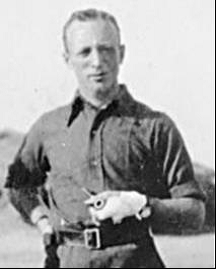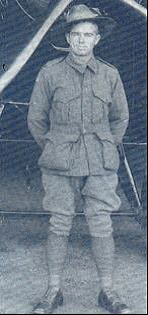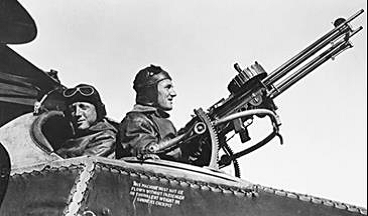This is an account of the wartime flying by Captain Ross Smith and Bristol Fighter B1229.
This aircraft was built in 1917, shipped to Egypt and issued to 1 Squadron AFC (Australian Flying Corps) on 17 March 1918, when it became Smith’s personal aircraft. Captain Smith flew 82 operational sorties in B1229, on ten of his eleven successful air-to-air actions and on many reconnaissance tasks. He was involved in the Hashemite Arab Revolt, had Colonel T.E. Lawrence, ‘Lawrence of Arabia’, as a passenger, and the plane survived engine failure and rough landings in open country.

One of 5,329 built, on 20 December 1917 B1229, in its crate, went by rail to Avonmouth, England, and was placed aboard the ship Carlo Castle which sailed for Egypt.
B1229 in Egypt -1918 and 1919
On 4 February 1918, B1229 arrived at X Air Depot (XAD), and on 12 February moved to Kantara, Egypt. At Kantara B1229 was checked thoroughly, and flown on test for 20 minutes on 28 February. This was its first flight. B1229 was issued to the Australian squadron after only 3 hours 55 minutes flying.
A year later, on 4 February 1919, B1229 was handed to 111 Squadron RAF in Palestine. By good fortune and the efforts of someone in the AFC or AIF, both the aircraft and the log book for B1229 were handed to the historical section of the Australian headquarters in Cairo for movement to Australia.
B1229 with 1 Squadron AFC
B1229 was one of eight Bristols that arrived in March, all fitted with 190 horsepower Rolls-Royce engines; all were allotted to C Flight, where Captain Smith was flight commander. He enlisted on 19 August 1914 in Adelaide, given Service Number 217, and allocated to B Squadron, 3rd Light Horse Regiment. Smith went to Gallipoli, was commissioned Second-Lieutenant on 5 September, evacuated ill, recovered in England and returned to his unit in 1916. Smith transferred to the AFC in October 1916, first as an observer, qualified as a pilot on 3 July 1917, and was posted to 67 (Australian) Squadron Royal Flying Corps, which later became 1 Squadron AFC. He was promoted to captain and position of flight commander on 29 November 1917. Ross Smith had been awarded the Military Cross (MC) as an observer for an action on 27 March 1917, in which he held enemy at bay with his pistol while a pilot forced down scrambled aboard.

B1229 was allocated to Air Mechanic Joe Bull. On 18 March, Bull worked all day on B1229, ‘fitting her up for service and checking measurements.’

1 Squadron AFC
In March 1918, 1 Squadron AFC was part of 40 Wing Royal Flying Corps (RFC), and was assigned a mixture of roles: to fly what were termed ‘strategic’ reconnaissance sorties over enemy-held locations far behind the front lines, while ‘tactical’ reconnaissance was of the front lines as far back as artillery positions. The squadron also was assigned photographic reconnaissance missions to provide vertical images for map-making, as useful maps of the war theatre did not exist, and to provide air photo mosaics for the information of ground forces, as well as oblique photos to show the ground or locations over which friendly forces would fight. 1 Squadron was the only one flying strategic reconnaissance tasks, so the demands for the accurate and up-to-date information from them were continuous.
B1229 received two experienced aviators as its air crew. Captain Ross Smith, with Lieutenant Ernest ‘Pard’ Mustard as observer, flew a strategic reconnaissance sortie in B1229 on 20 March. Mustard enlisted at Oakleigh, Victoria, on 19 August 1914, was on Gallipoli, promoted to sergeant, suffered mild wounds and illness, was commissioned Second-Lieutenant and appointed Signals Officer in the 4th Anzac Camel Battalion. He applied to transfer to AFC in July 1917, was posted on assessment to 67 (Australian) Squadron, and on 16 October 1917 was qualified as an observer.

The pilot and observer had to report on many details during a reconnaissance flight and compile a useful report on return to base. Sometimes a first version might be dropped to a land force headquarters, or a short version with important information telegraphed or given by telephone on return. To indicate what was required of a crew on strategic reconnaissance, some detail is provided here. Smith reported on
a ‘normal’ appearance of camps at Shunet Nimrin;
the bridge was normal, with three new tents;
two motor vehicles and 80 cavalry were moving south on the road to Es Salt;
at Es Salt there were 18 horse-drawn wagons, some scattered cavalry, 22 bell tents, two marquees and 30 small shelters − a marked decrease − six wagons and 80 horses in three lines, with two dumps of fodder, and ten camels moving north;
on the road to Es Salt from Amman there were 300 cavalry close to Es Salt, and wagons, trucks and men (details given of each), numbers of different type of tents in camps seen along the road;
at Amman similarly reported were the numbers and direction of travel of wagons, motor vehicles, cavalry, the locations and numbers of different type of tents, with large quantities of rail-way rails and timber stacked at the rail station, but little movement seen;
at Jier Ed Damie tents reported previously had been removed, tents and shelters at a bridge had been removed, and there was a decrease of 30 from previously reported 98 tents at a camp; and
camps were normal at Wadi Fusail.
This account of B1229 and Captain Smith in 1 Squadron will only include highlights for reasons of space; many more flights were made than related here. On 1 May the Smith/Mustard crew was escort to a bombing raid, saw cavalry and infantry, so attacked with machine guns. Next day B1229 received a general overhaul, after having flown a total of sixty-six flying hours.
On 16 May Smith took B1229 with Colonel T.E. Lawrence in the rear cockpit to contact the Hashemite Arab Revolt leaders. This was not a simple taxi service flight for Smith, who used the opportunity to report on detail seen below, and he noted activity or lack of it, with information about the airfield at Kutrani. Smith flew B1229 low over this airfield and gave a good description of it.
At the end of May, the following was painted on the starboard side of the fuselage of B1229:
New South Wales No.11
The Mackintyre
Kayuga Estate
This commemorated the purchase of a Bristol Fighter, of 2,700-pounds, donated by Mrs C.H. Macintyre, executrix of the late Donald Macintyre, Kayuga Station, Muswellbrook.
On 21 June, Smith and observer Walter Kirk went down to 1,000 feet and machine gunned a train, flying alongside it, then strafed two railway stations, a motor transport park, a camp, and flew along a road shooting at everything found on it.
In early July, Joe Bull fitted a new tail skid, with shock absorbers, and gave B1229 a ‘clean down’, examined all internal bracing and control wires, ‘trued up’ the fuselage, repaired fabric, fitted another new tail skid, painted the propellor, inspected bracing wires, varnished the camera box, and tightened the bolts in the upper and lower centre sections.
Another rampage over enemy territory flown by Smith was on 11 July. After a patrol, Smith went to Balata airfield, strafed it from 1,500 feet, and continued to shoot into a nearby camp, parked transport, a barracks, transport along the Bireh road and cavalry.
On 17 July Smith shot down an Albatros of Jasta 1F and machine gunned targets from low level − 50 feet − and higher. Then the engine failed and Smith made a forced landing, to which the squadron sent a repair crew who replaced the engine. The work necessary on B1229 was recorded in the aircraft log book, and was: new rudder, new lower pin, new cross member in fuselage for skid attachment, new skid complete with shock absorber & fittings, new port radius bars on skid post. Fuselage and tail plane trued up. Fabric repaired. Clean down. Stripped the machine and put in a new skid cross member and trussed up the fuselage.
In August, Joe Bull cleaned the aircraft, adjusted the bracing wires inside the fuselage, painted the propellor and wing centre section, fitted a new tail skid, cleaned the wheels and greased them, put new bolts in the wheel collars, examined the bracing and control wires, patched the centre section and propellor, and placed new shutters and controls on the Aldis gun-sight. Smith flew many reconnaissance and enemy aircraft patrols.
September was to see the effective culmination of planning by General Allenby and his staff for an offensive that would destroy completely the enemy in Palestine and result in the end of the Ottoman Empire. Allenby had convinced the enemy that his intention was to attack in the east, when he intended to do so in the west, along the coast, and had gathered his attacking force, with artillery, there. Much of this success was due to the reports of the 1 Squadron AFC crews who flew reconnaissance operations over enemy territory.
Over the past few days, along with daily servicing, Bull had put new shock absorbers on the tail skid, installed a new starboard undercarriage Vee-strut and wing skid, and new shock absorbers on the starboard side, patched the lower wing centre section, and done inspections and cleaning.
On 22 September there was a different role for B1229. Joe Bull was up long before daylight to take the bombs and racks off B1229 and fasten a couple of tins of petrol on. Captain Smith and Lieutenant Mustard went to the Arab Revolt forces near Deraa. While there, a look-out signalled four aircraft approaching – Germans. In full view of the gathered Arabs and British military personnel the two Bristols attacked the enemy, Smith destroyed the two-seater.
On 5 October the squadron received word that five officers had been awarded the DFC – four had flown in B1229: Lieutenants Harold Maughan, Mustard and Albert Tonkin, and Captain Smith received a Bar to the DFC.
Joe Bull was busy with B1229, and in October cleaned and repaired the lower wing centre section, cleaned and greased all wires, repaired the fabric on all wings, painted the struts, inspected the air frame, removed the skid controls, replaced the starboard wheel, put new bolts in the collar of the port wheel, gave B1229 a complete overhaul, opened the centre section of the top wing and tightened the cross bracings, followed by a cleaning.
On 19 October, Smith claimed his final victory. The enemy was forced down, and Smith flew past at 50 feet while observer Ashley McCann fired 200 rounds into it, but it would not burn, whereupon Smith landed close by and McCann fired a Very light into its cockpit, setting it on fire. The details of the German aircraft were noted: a DFW two-seater, with usual markings, factory number 4490/18.
On 26 October there was another adventure for B1229: Lieutenant Norman Hazelwood had to make a forced landing. B1229 was missing on 27-28-29 October, ‘found’ next day, and returned to the squadron. An Armistice was signed on 31 October, to come into effect at once.
There was little flying activity under the terms of the Armistice. B1229 was brought back to base; Joe Bull gave it a complete overhaul: patching the rudder, lower fin and tail, installing a new port aileron, truing the fuselage, installing a new strut in the port side of the fuselage, a new tube in the port wheel, greasing the wheels, cleaning and inspecting.
On 23 December, B1229 flew to Cairo for air display and an escort to General Allenby, by Lieutenant Headlam and Air Mechanic Hewett.
By the end of its service with 1 Squadron AFC, B1229 had flown 356 hours 51 minutes.
On 4 February 1919, B1229 was signed over to 111 Squadron RAF. On 14 May 1919 it was dismantled, placed in a case and, on the authority of the RAF Command in Palestine, handed over to the Australian War Records Section, Australian Depot Stores, Gezireh, Cairo. B1229 had flown for 396 hours.
The aircraft left Egypt for Australia aboard Booral in 1919, arrived safely, and reportedly was put on display in Adelaide by the Motor Traders Association of South Australia in 1920. Confirmed documentation is missing, but it is ‘thought’ to have been destroyed in a Melbourne fire in 1924 or moved to Sydney in 1925, after which nothing was recorded.
B1229 – an aircraft of interest.
B1229 took part in some of the most advanced military operations of 1918, was involved in the Hashemite Arab Revolt, and was flown by two leading Australian air crew, Smith and Mustard, in ten successful air combats, and by a number of other experienced squadron air crew.
If by great good fortune, B1229, or parts of it, including the engine, are in an aviation museum somewhere, it is the property of the Australian War Memorial, Canberra.
By Lex McAulay for MHSNSW Reconnaissance, Spring 2019
Lex MacAulay is one Australia’s best known military historians. He joined the Regular Army in 1960 and served three tours in Vietnam, 1965-66, 67-68, 70-71. He resigned in 1982 and has written twenty books − one on WW1, eight on Vietnam, six on RAAF in WW2, and five on the New Guinea campaign.
Appendix A
Bristol Fighter B1229
This aircraft was built by the British & Colonial Company, Filton, as part of contract 87.a.552, was fitted with a Rolls-Royce Falcon Type 111 No. 18634, and delivered on 15 December 1917. B1229 was fitted with:
Hughes Compass No. 2192,
Mason aneroid No. 12200,
Foxboro thermometer No. 929P,
North Revolution counter No. 4183,
Elliott air speed counter No. 1100,
B&E clock No. 1000F,
SS&S inclinometer No. 2139, and
S&B air pressure gauge No. 5565654.
Engine Rolls-Royce Falcon Mark 111 No. WD18634.
A four-bladed propellor, DP3045 D2850 P2750 was fitted on 5 March.
At 1 Squadron Aldis sight No. 78567 for the Vickers gun was fitted.
Engines fitted to B1229:
In construction, Rolls-Royce Falcon Mk111 No.WD18634.
On 13.05.18 Rolls-Royce Falcon Mk111 No.WD18606.
On 18.07.18 Rolls-Royce Falcon Mk111 No.WD18571.
On 18.11.18 Rolls-Royce Falcon Mk111 No.WD39412.
This engine was still fitted when B1229 was handed to the Australian Historical office in Cairo.
Appendix B
Flights by B1229 with 1 Sqn AFC March 1918-January 1919
Operational – 112
Non-operational – tests, staging, liaison – 70
Appendix C
Ground Crew of B1229
Bull, Air Mechanic Joseph
Bull was No.501, Third Reinforcements, 1 Sqn AFC; 20.10.1916 sailed aboard SS Barunga; 14.10.16 to the sqn at Kantara; Returned To Australia (RTA) 12.04.19; died 26.05.1981.
Luxton, Corporal Albert
Enlisted Brisbane 21.10.15 as original member of 1 Sqn, No.303; allocated to C Flight; to Cpl 1.03.18; RTA 4.03.19, discharged 8.06.19.
Appendix D
Air Crew operational flights in B1229
Tests, delivery and other non-operational flights are not included.
Smith, Ross, pilot 82
Kirk, Walter, observer 40
Mustard, Ernest ‘Pard’, observer 30
Tonkin, Albert, pilot 15
Maughan, Harold, pilot 12
Sutherland, Leslie, observer 08
McCann, Ashley, observer 07
Weir, William , observer 07
Sixteen other men flew lesser totals of sorties in B1229, including Hudson Fysh, with two.
Sources
Australian War Memorial (AWM)
Log book for B1229
1 Sqn war diaries, 1918
National Australia Archives (NAA)
Personal files
Information from Michael V. Nelmes, Canberra.
Contact MHHV Friend about this article.






